Ana Maria Micu is a Romanian artist who creates drawings, paintings and animations of herself and her surroundings. Her solo exhibition, A Picture on the Wall (牆上的圖像), at Mindset Art Center features black-and-white charcoal self-portraits juxtaposed with colorful oil paintings of her home and studio interiors. Micu is interested in story fragments; she is fascinated “with the fact that she is able to force coherence out of a broken narrative, apparently on a criterion of which she is not fully aware,” writes the gallery. In her paintings, the artist depicts cluttered interiors, drawing attention to potted plants thriving in one corner of a room, unfinished paintings taped to a wall, or bags and clothes hanging on the back of a door. “Marks of the passage of time, the endearing idealism of obsolete design, things that were left behind, abandoned or broken, are the details that the artist notices, allowing herself to be changed by her observations as she paints.”
■ Mind Set Art Center (安卓藝術) 108, Heping E Rd, Taipei City (台北市和平東路108號), tel: (02) 2365-6008. Open Tuesdays to Saturdays from 11am to 6pm
■ Until Jan. 12
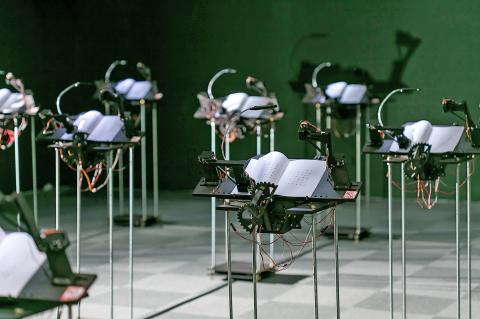
Photo Courtesy of Taipei Fine Art Museum
Double Square Gallery presents Apeiron (未定物), a solo exhibition by Wu Tung-Lung (吳東龍). The title is a Greek word that means unlimited, boundless or infinite — a term that critic Chien Tzu-chieh (簡子傑) uses in an essay to describe Wu’s painting language. Wu is known for creating minimalist paintings that feature subtle layers of colors, organic shapes and spaces. These features, though abstract, suggest nuanced meanings and sensibilities. The artist renders “pure and minimalist symbols in a rationally checked yet emotionally charged manner,” writes the gallery. He insists on a hands-on process that involves repetitive work with paint, tape and plaster to create distinct qualities on canvas. In this show, the artist presents 30 paintings from two ongoing series, Symbol and Color Lines, as well as two new series of small-scale works, Little Blocks and Little Symbol. “Wu’s work [conveys] a powerful visual tension and understated emotions while establishing a distinctive style through its minimal, simplified and rational appeal,” writes the gallery.
■ Double Square Gallery (雙方藝廊), 28, Lane 770, Beian Road, Taipei City (台北市北安路770巷28號), tel: (02) 8501-2138. Open Tuesdays to Sundays from 10:30am to 6:30pm
■ Until Feb. 1
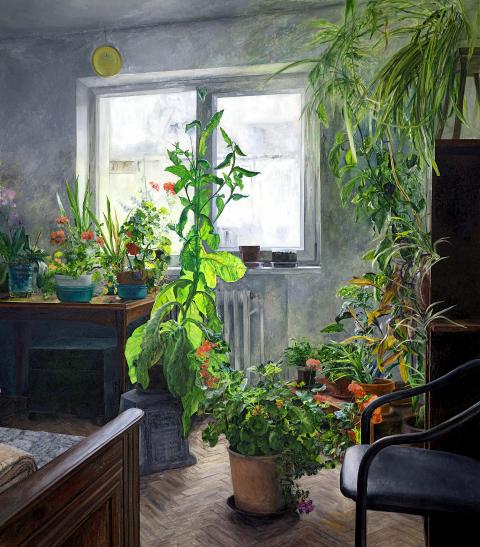
Photo Courtesy of Mindset Art Center
It is the time of year for the annual Taipei Art Awards (臺北美術獎), the city’s prestigious contemporary art competition organized by the Taipei Department of Cultural Affairs. For the last 30 years, the award has attested to the developments in the local arts community, celebrating artists that push the frontiers of art. Each year submissions are made by open call and judged by a panel of art professionals to produce 14 finalists. This year the selected projects incorporate a variety of mediums including video, installation, audio-visual art, kinetic art, sculpture and lecture performances, among others. Chang Wen-hsuan’s (張紋瑄) Suicide Technique Foundation: Annual Presentation, International Suicide Award features a presentation room showcasing materials for a fictional competition called the International Suicide Award. The controversial project touches on topics of social taboo such as the death, suicide and the power of storytelling. Yu Siuan’s (于軒) Klein Hertz: A Nonexistent Laboratory is a painting installation featuring strange, scientific instruments found in the laboratory of fictional scientist Klein Hurtz. The artist has been developing the narrative of Klein Hurtz and his inventions by painting over readymade objects of casts with realistic detail.
■ Taipei Fine Arts Museum (台北市立美術館, TFAM), 181, Zhongshan N Rd Sec 3, Taipei (台北市中山北路三段181號), tel: (02) 2595-7656. Open Tuesdays to Sundays from 9:30am to 5:30pm and until 8:30pm on Saturdays
■ Until March 31

Kaohsiung’s Yiri Arts Pier-2 is presently hosting a solo exhibition by Spanish artist Guim Tio Zarraluki. Playing with Fire features new paintings that explore the relationship between humans, nature and society. This appears to be a new direction for the artist, whose earlier works focus on portraiture that examines the human condition. Zarraluki’s figurative work involves manipulation of fashion magazine images with chemicals and oil pastels to create stylized figures with ironic and exaggerated features. By contrast, Zarraluki’s new series of paintings depict small representations of humans traveling amid vast landscapes. This change in perspective seems to suggest a shift in Zarraluki’s ways of seeing. “In the past, Zarraluki had asked, where do we come from? And now, He desires to know where we will we go?” writes the gallery in a press release. La Pujada is an oil painting that depicts three figures walking through a white, minimalist mountainscape. The figures leave behind a trail of footprints that trace their trajectory uphill. In Tavascan , a lone figure walks through a snowy scene intersected by patches of black terrain towards the other side of the mountain.
■ Yiri Arts Pier-2 (伊日藝術駁二空間), Pier-2 Art Center Unit C9-14, 1 Dayong Rd, Kaohsiung City (高雄市大勇路1號駁二藝術特區大義倉群C9-14倉庫), tel: (07) 521-5783. Open Tuesdays to Sundays from 1pm to 7pm
■ Until Jan. 13
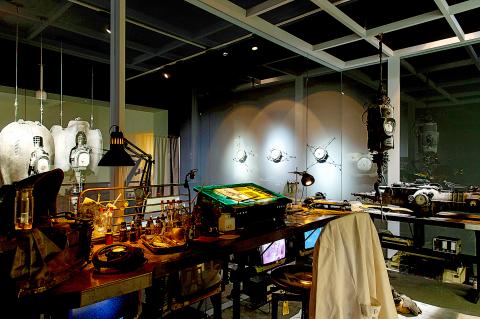
Photo Courtesy of Taipei Fine Art Museum
A video art program, Who’s Singin’ (是誰在唱歌), is currently on view at the Museum of Contemporary Art Taipei’s main plaza. The program consists of four artists who explore the behavior of singing and its associated video culture. In the curatorial preface, curator Huang Hsiang-ning (黃香凝) speaks of the history of karaoke in Taiwan and its rise to popularity in the late 80s. While karaoke culture was first introduced to Taiwan from Japan, “the successful business model of Taiwanese KTV spread [back] to Japan” in the 90’s where it became a “popular leisure activity found in households, restaurants and the countryside for people to briefly escape the pressure of everyday life,” writes Huang. The artists use the karaoke format as a departure point to reflect on various historical and social issues. Yu Cheng-ta’s (余政達) A Practice of Singing: Japanese Songs is a video that addresses the cultural translations between Japan and Taiwan and the transformation of meaning during the process. Chen Han-yu’s (陳含瑜) The Sungai Duri Karaoke Project narrates family relationships between Indonesia and Taiwan through film and song.
■ Museum of Contemporary Art, Taipei (台北當代藝術館, MOCA, Taipei), 39 Changan W Rd, Taipei City (台北市長安西路39號), tel: (02) 2552-3721. Open Tuesdays to Sundays from 10am to 6pm
■ Until Jan. 27
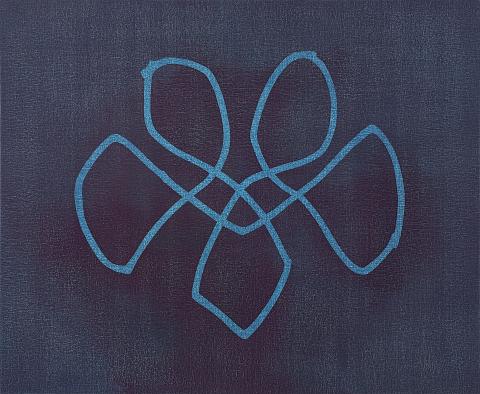
Photo Courtesy of Double Square Gallery

Photo Courtesy of Museum of Contemporary Art Taipei
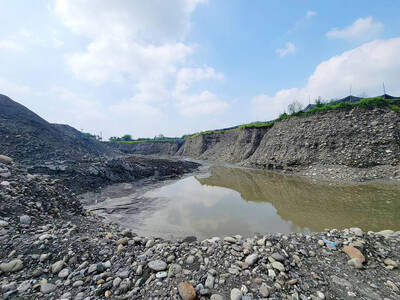
Last week the story of the giant illegal crater dug in Kaohsiung’s Meinong District (美濃) emerged into the public consciousness. The site was used for sand and gravel extraction, and then filled with construction waste. Locals referred to it sardonically as the “Meinong Grand Canyon,” according to media reports, because it was 2 hectares in length and 10 meters deep. The land involved included both state-owned and local farm land. Local media said that the site had generated NT$300 million in profits, against fines of a few million and the loss of some excavators. OFFICIAL CORRUPTION? The site had been seized

The depressing numbers continue to pile up, like casualty lists after a lost battle. This week, after the government announced the 19th straight month of population decline, the Ministry of the Interior said that Taiwan is expected to lose 6.67 million workers in two waves of retirement over the next 15 years. According to the Ministry of Labor (MOL), Taiwan has a workforce of 11.6 million (as of July). The over-15 population was 20.244 million last year. EARLY RETIREMENT Early retirement is going to make these waves a tsunami. According to the Directorate General of Budget Accounting and Statistics (DGBAS), the
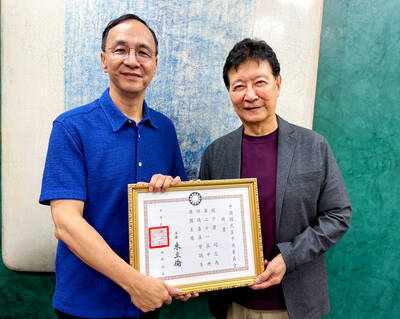
Next week, candidates will officially register to run for chair of the Chinese Nationalist Party (KMT). By the end of Friday, we will know who has registered for the Oct. 18 election. The number of declared candidates has been fluctuating daily. Some candidates registering may be disqualified, so the final list may be in flux for weeks. The list of likely candidates ranges from deep blue to deeper blue to deepest blue, bordering on red (pro-Chinese Communist Party, CCP). Unless current Chairman Eric Chu (朱立倫) can be convinced to run for re-election, the party looks likely to shift towards more hardline

Sept. 15 to Sept. 21 A Bhutanese princess caught at Taoyuan Airport with 22 rhino horns — worth about NT$31 million today — might have been just another curious front-page story. But the Sept. 17, 1993 incident came at a sensitive moment. Taiwan, dubbed “Die-wan” by the British conservationist group Environmental Investigation Agency (EIA), was under international fire for being a major hub for rhino horn. Just 10 days earlier, US secretary of the interior Bruce Babbitt had recommended sanctions against Taiwan for its “failure to end its participation in rhinoceros horn trade.” Even though Taiwan had restricted imports since 1985 and enacted